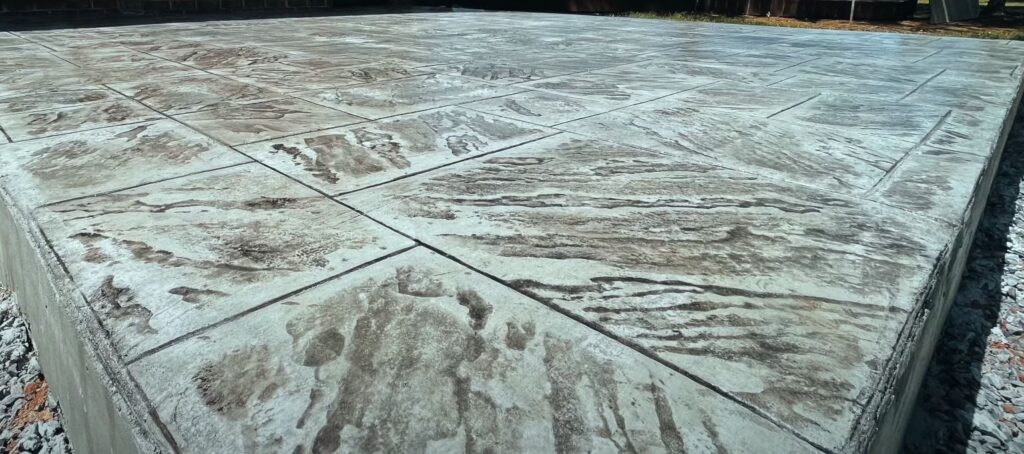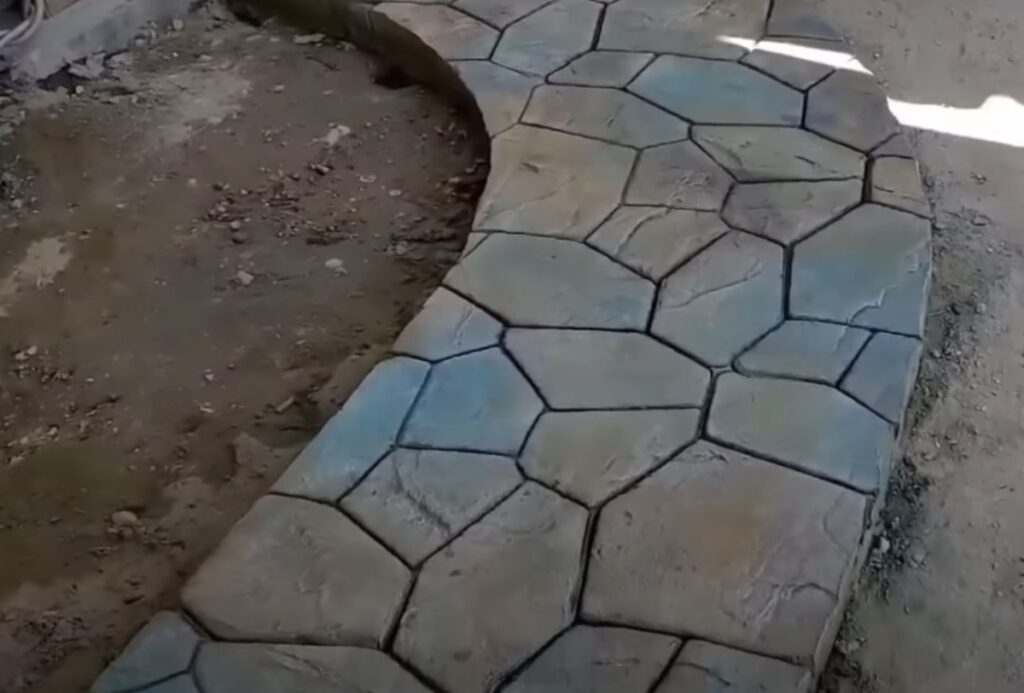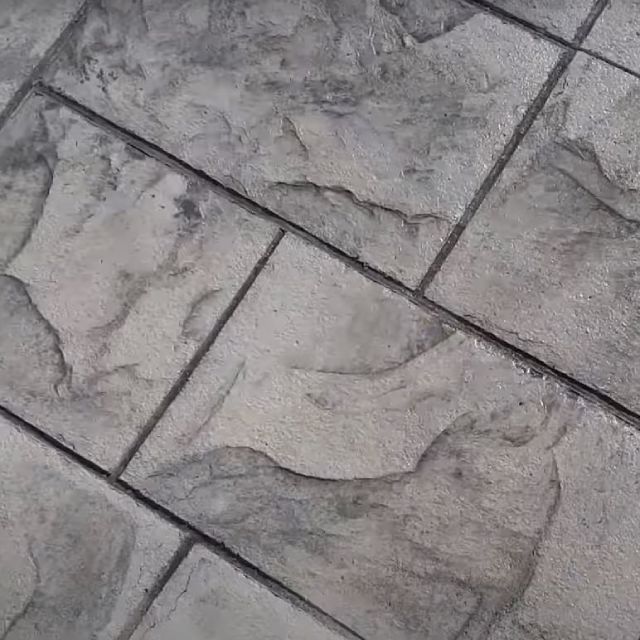Stamped Concrete and its Potential Uses
Stamped concrete is a versatile and cost-effective solution that can indeed mimic the appearance of more expensive materials such as brick, wood, or natural stone. This decorative concrete option has gained popularity in Auckland, including suburbs like Ellerslie and Glenfield, for its ability to enhance both residential and commercial properties.
Versatility and Design Options
Stamped concrete offers a wide range of design possibilities. With various stamp designs and colors available, it can easily match and complement surrounding features like fire pits or garden pathways. The ability to customize its look with intricate designs, such as a stamped compass within an Ashlar pattern, adds a creative touch to any space.
Here are some examples of stamped concrete designs and their use cases:
- Slate Texture: Concrete stamped to look like slate is ideal for patios, walkways, and pool decks. Its texture provides an elegant, natural stone appearance.
- Seamless Stone: This pattern gives concrete the look of real stone, suitable for enhancing outdoor areas with a classic touch.
- Arizona Flagstone: Featuring multiple size stones with random shapes, this pattern is perfect for creating an authentic flagstone appearance, commonly used for patios and pathways.
- Roman Slate: Common for any type of patio, Roman Slate offers a slightly different texture within the slate family, complementing a variety of color combinations.
- Italian Slate: Similar to Roman Slate but with a unique texture, Italian Slate is another option within the slate family, versatile for various outdoor applications.
- Seamless Old Granite: Ideal for stamping concrete stairs and steps, this pattern resembles the appearance of old granite, complete with natural-looking veins.
- Random Stone: Great for patios and walkways, this pattern replicates the look of random fieldstones with a heavily textured surface.
- Classic Wood: Combining multiple wood grains, this pattern is excellent for creating a bold, pronounced wood appearance, suitable for patios and interior floors.
- Running Bond New Brick: This pattern mimics a traditional brick layout, perfect for driveways or paths where a classic brick appearance is desired.
- Herringbone New Brick: Resembling bricks laid in a zig-zag pattern, this design is timeless and adaptable for various project sizes.
Stamped concrete is not only versatile in its design capabilities but also offers durability and low maintenance, making it a popular choice in the Auckland region, including areas like Ellerslie and Glenfield. Whether it’s for a residential driveway or a commercial walkway, stamped concrete can enhance the aesthetic appeal while being cost-effective
Cost-Effectiveness
One of the key advantages of stamped concrete is its affordability compared to the materials it imitates. The cost of installation varies based on design complexity but generally remains lower than that of natural materials. For example, while a brick patio may cost about $17 per square foot, a stamped concrete patio might only cost around $8 to $18 per square foot.
Durability and Maintenance
In terms of durability, stamped concrete stands out as one of the most resilient patio materials. It requires less maintenance than other options like concrete pavers, which involve replacing joint sand periodically. Regular maintenance includes simple sweeping and periodic rinsing.
Eco-Friendly Aspect
From an environmental perspective, concrete is a sustainable choice. It’s made from abundant materials like limestone, water, and sand, and can be recycled, thus reducing environmental impact. This makes stamped concrete an eco-friendly option for those conscious about sustainable living.
Safety and Comfort Considerations
While stamped concrete offers many benefits, it’s important to be aware of its drawbacks. Concrete can be hard and uncomfortable to stand on for prolonged periods. It’s also susceptible to moisture issues, especially in below-grade areas, and can be slippery when wet. Regular sealing with a non-skid additive is recommended for areas like pool decks to improve slip resistance and safety.
Ideal Applications
Stamped concrete is ideal for various applications, including garden pathways, pool decks, and outdoor entertainment and concrete patios areas like kitchens or fire pits. Its heat-resistant properties make it a safe choice for areas around grills and fire pits.
For Aucklanders considering a concreting project in Ellerslie, Glenfield, or surrounding areas, stamped concrete offers a blend of aesthetic appeal, cost-effectiveness, and durability. Professional Concrete Driveways Auckland can provide expertise and quality service for such projects, ensuring a balance between practicality and style
Essential Frequently Asked Questions on Stamped Concrete
What is Stamped Concrete? Stamped concrete is a decorative concrete option where the surface is imprinted with patterns to mimic materials like stone, brick, or wood.
How Durable is Stamped Concrete? Stamped concrete is highly durable, resisting wear and tear effectively and lasting many years with proper maintenance.
Can Stamped Concrete Mimic Other Materials Accurately? Yes, it can very closely mimic the look and texture of various materials such as slate, stone, and wood.
Is Stamped Concrete Slippery? It can be slippery when wet, but slip-resistant additives can be used during sealing to enhance safety.
What Maintenance Does Stamped Concrete Require? Regular sweeping, occasional rinsing, and resealing every few years are typically sufficient for maintenance.
How Much Does Stamped Concrete Cost? Cost varies but is generally less expensive than the natural materials it imitates, with prices ranging based on design complexity.
Can Stamped Concrete Crack Over Time? Like any concrete, it can develop cracks due to temperature changes, moisture, and settling, but these can usually be repaired.
Is Stamped Concrete Suitable for Driveways? Yes, its durability and design flexibility make it a popular choice for driveways.
Can Stamped Concrete Be Used Indoors? Absolutely, it’s a stylish and durable option for interior floors.
What Are Popular Patterns for Stamped Concrete? Slate, cobblestone, and wood patterns are among the most popular choices.
Is Stamped Concrete Eco-Friendly? Concrete is a sustainable material, and stamped concrete uses less natural resources compared to real stone or wood.
How Long Does Stamped Concrete Last? With proper installation and maintenance, it can last for decades.
Can the Color of Stamped Concrete Fade? Over time and with exposure to elements, some fading is possible, but sealants help protect the color.
Is Stamped Concrete a Good Option for Pool Decks? Yes, especially with a non-skid additive, it’s an excellent, durable choice for pool areas.
How Customizable is Stamped Concrete? It offers high customization in terms of patterns, textures, and colors.
Can You Install Stamped Concrete Over Existing Concrete? Yes, it can be installed over existing concrete if the base is in good condition.
What Is the Best Time of Year to Install Stamped Concrete? Milder temperatures, typically in spring or fall, are ideal for concrete work.
Does Stamped Concrete Require Special Tools for Installation? Special stamping mats and tools are needed for imprinting the patterns.
Can Stamped Concrete Be Repaired if Damaged? Minor damages can often be repaired without needing to replace the entire section.
Is Stamped Concrete Only for Outdoor Use? No, it’s also an attractive and practical option for indoor spaces, including basements and living areas.
These questions cover the key aspects of stamped concrete, from its durability and design options to installation and maintenance




